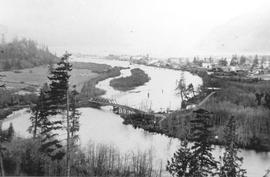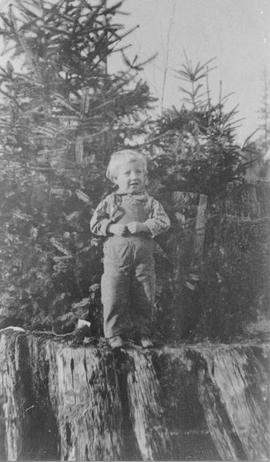- CA SQPL 06-076
- ~1910
Yapp's logging camp on the Cheekye River above the railroad bridge. Photo taken around 1910.
In 1907, Allan Newton Barbour and his brother Charles came to Squamish and logged using 6 yoke of oxen and took out six 24' logs a "turn" (load). The area logged was near the PGE Shops (by Castle's Crossing), across the river rom the shops, on the Burnt Ground near the cemetery, at Paradise Valley, and about five miles north of Cheekye. 2 to 20 men were employed. It was customary to log close to the river so the logs just had to be dragged into the river and floated to the Howe Sound where they were picked up by the Powell River company tugs and taken up to their mills. Log jams were broken up by men in canoes. Mr McComb was the first to tow logs down the river in a boat. The Barbours would later sell out to Mr Yapp. Mr Yapp's Squamish Timber Company was incorporated on March 21, 1907. In 1910, the Yapp Company cleared the Cheekye area. A steam donkey would haul the logs 400 feet and then an 8 horse team hauled them 1/2 mile on a skid road. Another donkey, called a roader, took the logs to the river. Here the logs followed a log trough. Instead of chokers, logging dogs were used. When the Howe Sound Northern Railway came into Cheakamus, the Yapp company used the train to transport logs to the booming grounds at Squamish. In 1911, a company owned by Mr Lamb took over the Yapp stand of timber.
Research compiled by Eric Andersen, 2011: The location of the camp is actually above the highway bridge and not the railway bridge.
The Squamish Timber Company is often referred to as "Yapp's", after company boss Chester Yapp. According to one source, the company was incorporated in March 1907. It was operating on the Cheekye Fan by 1908.
























